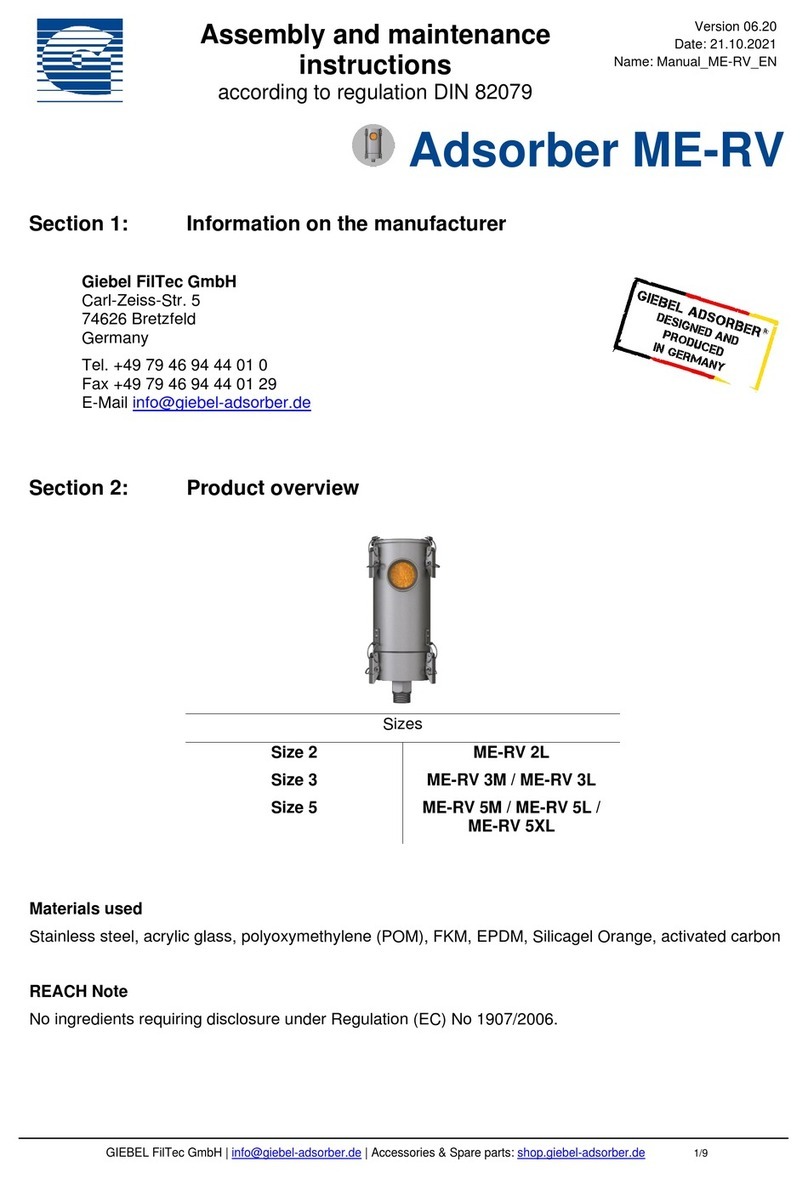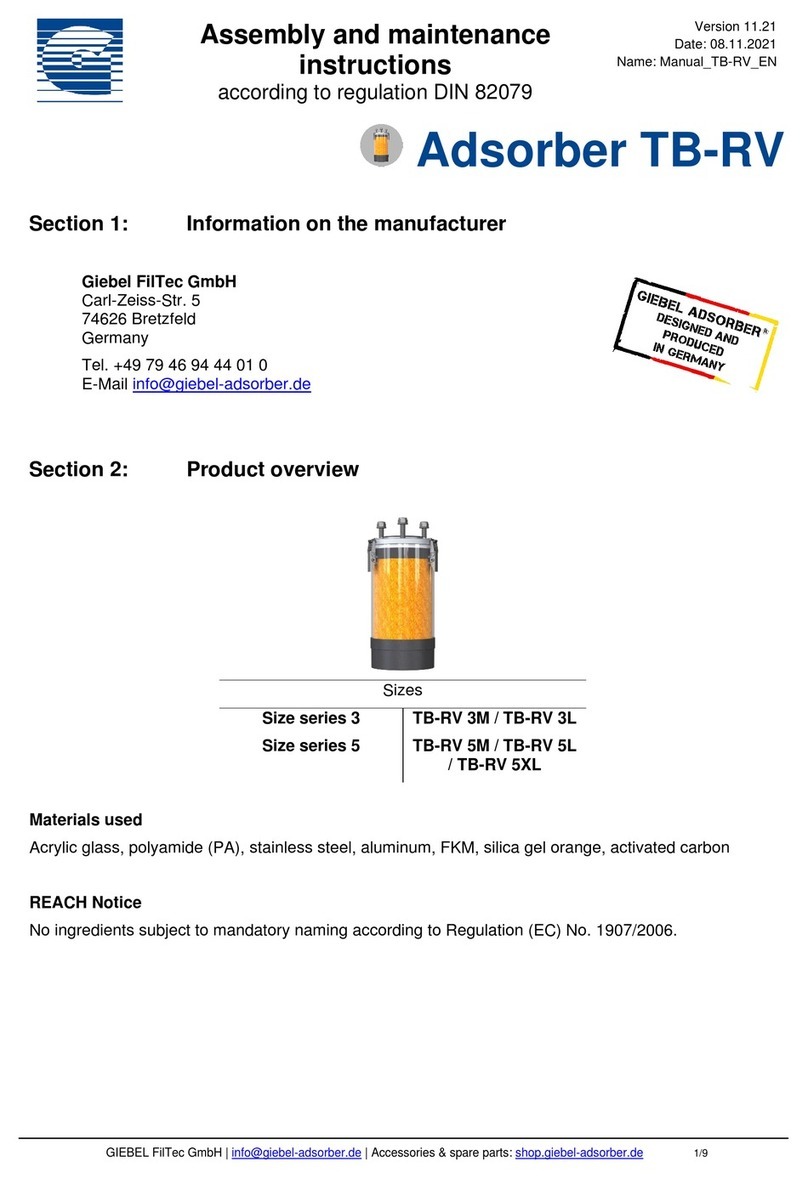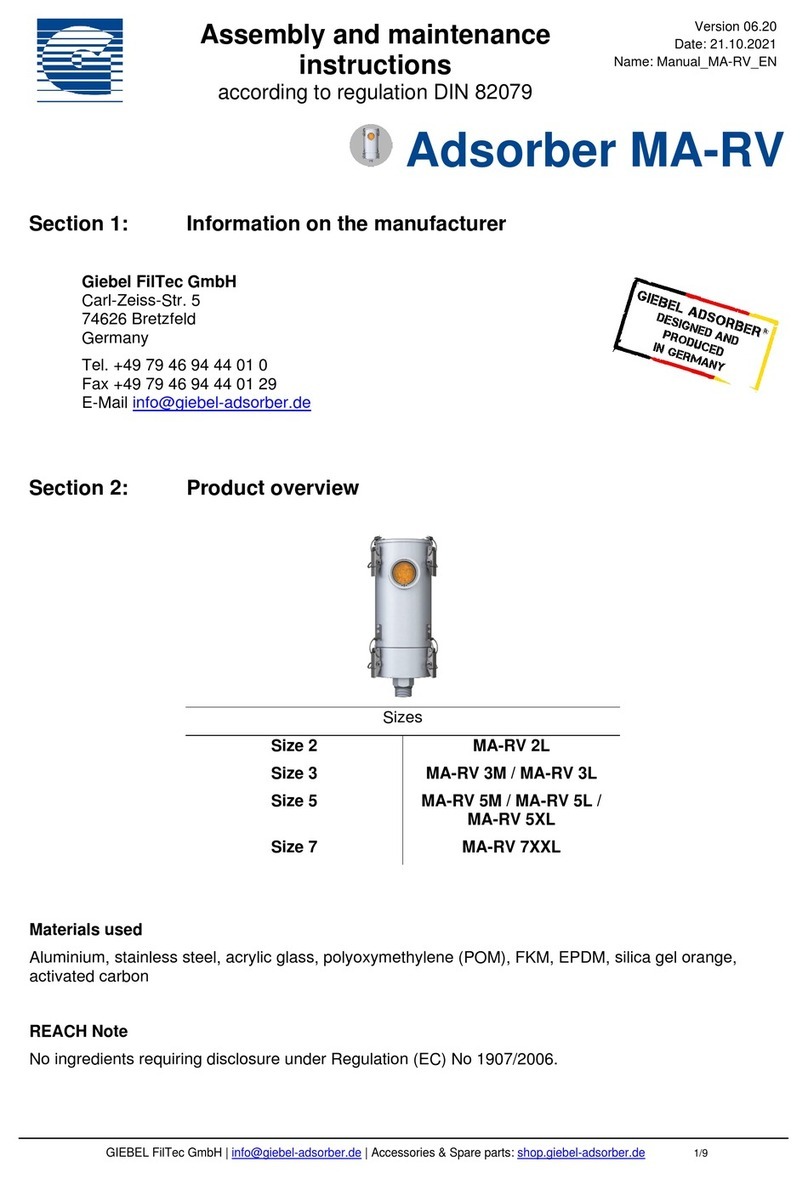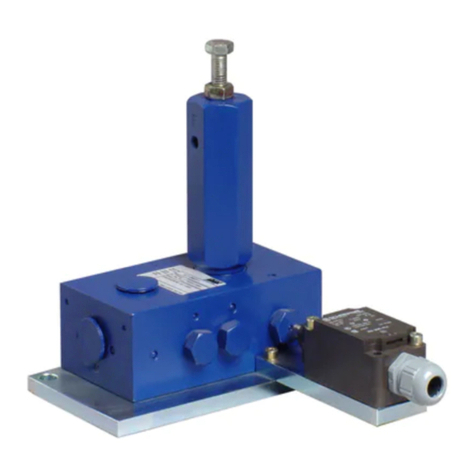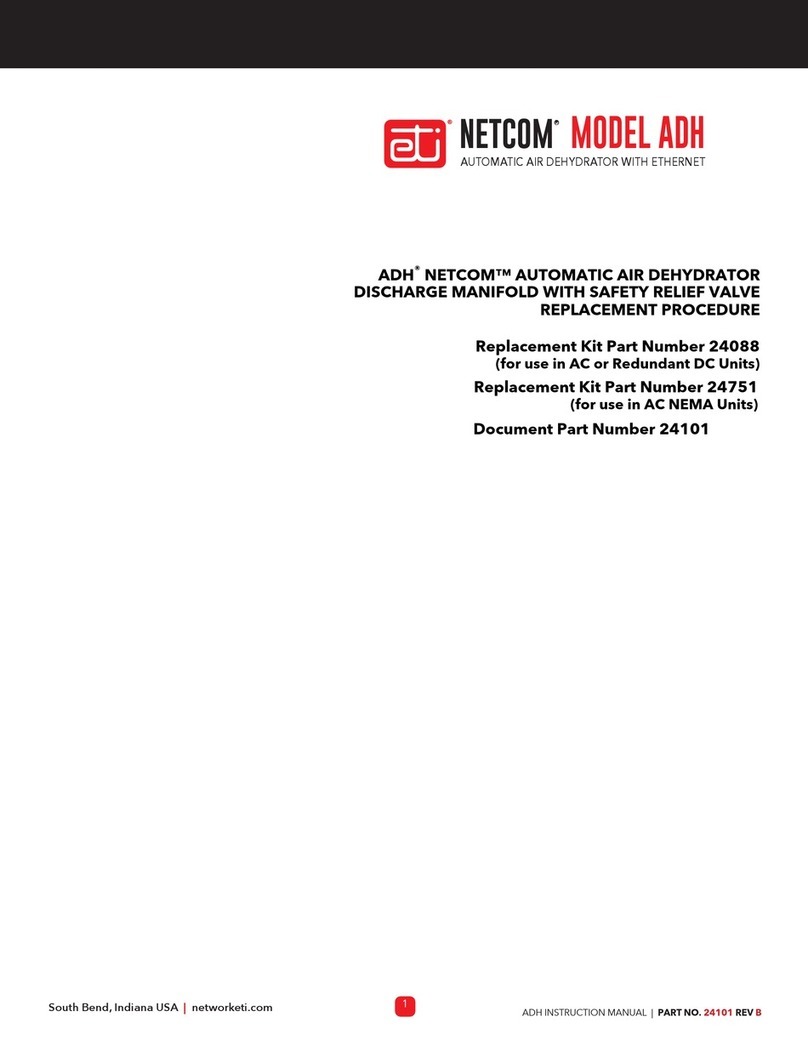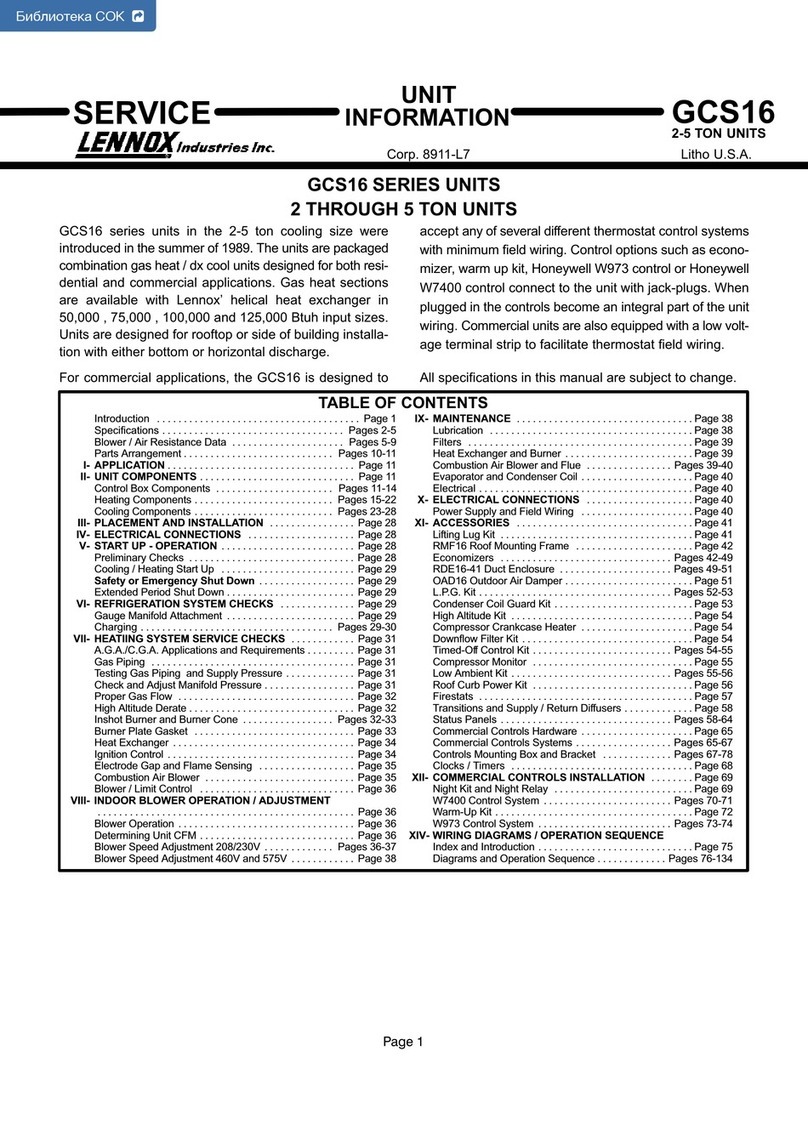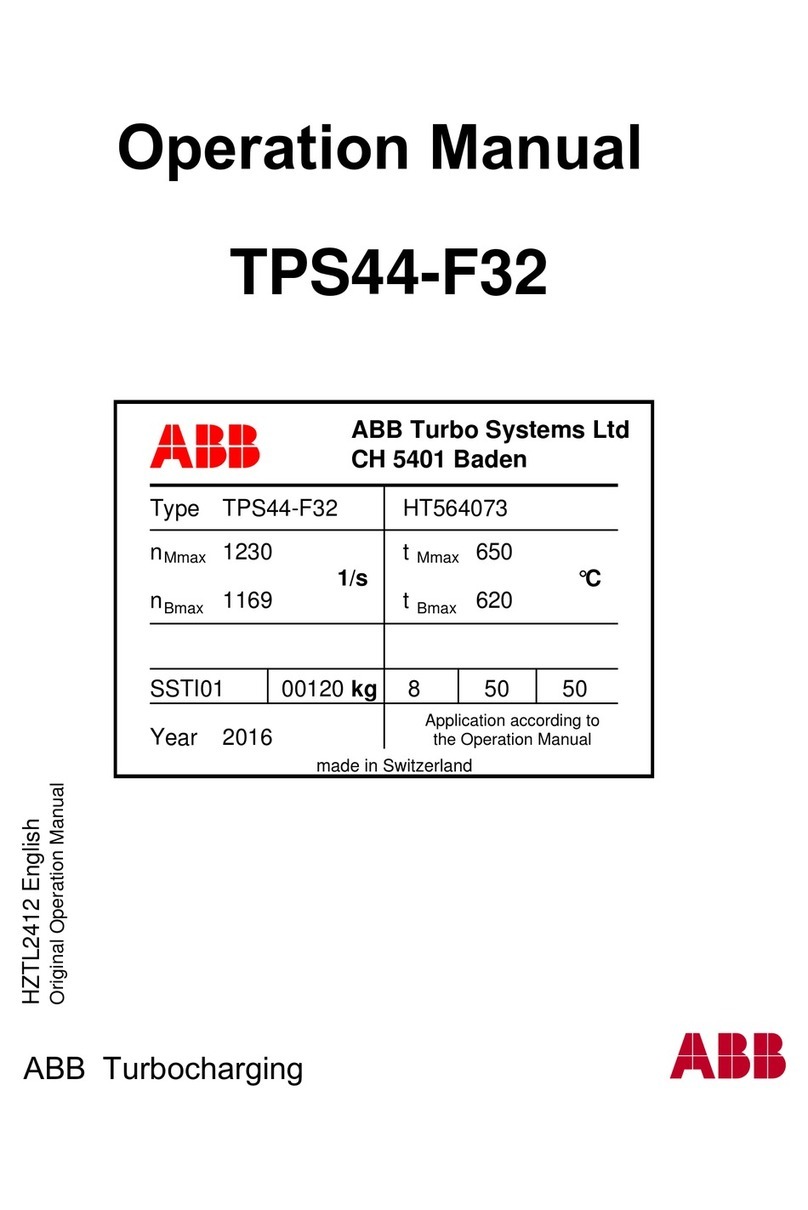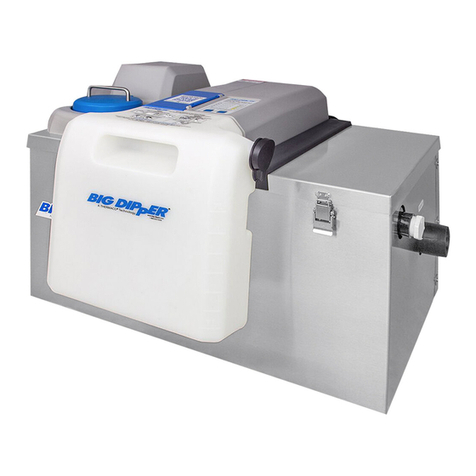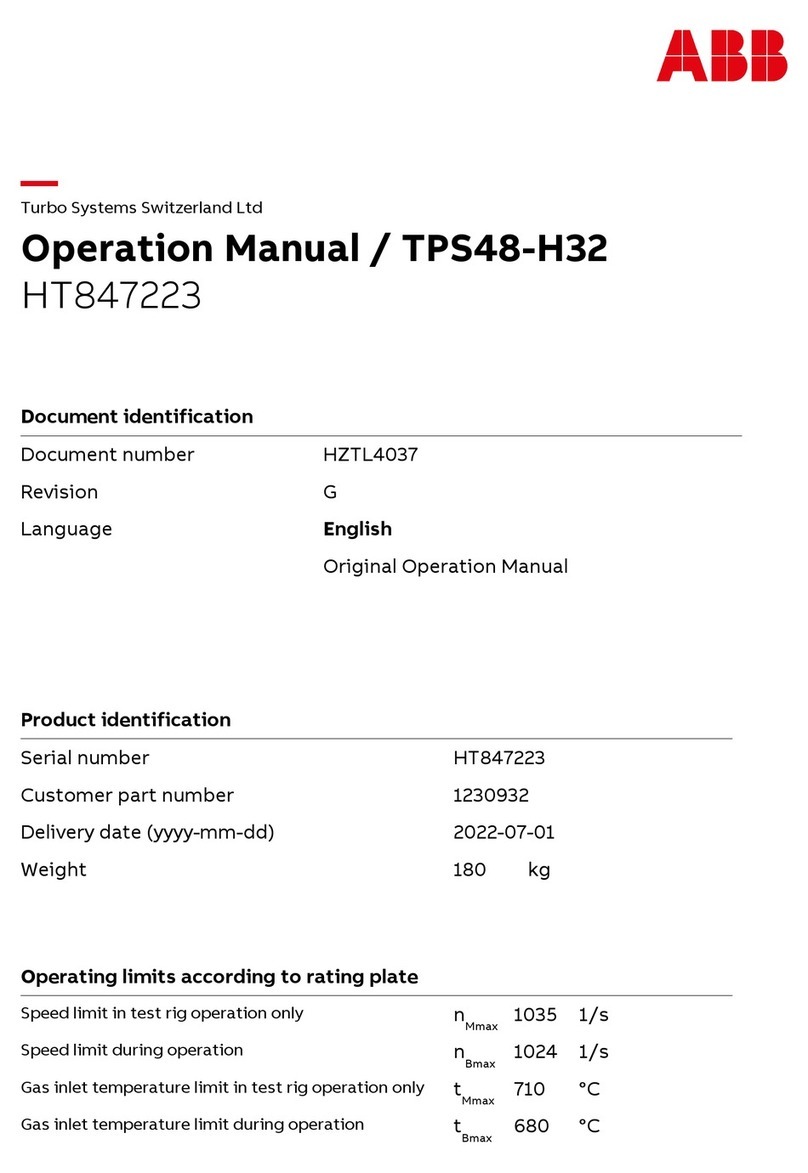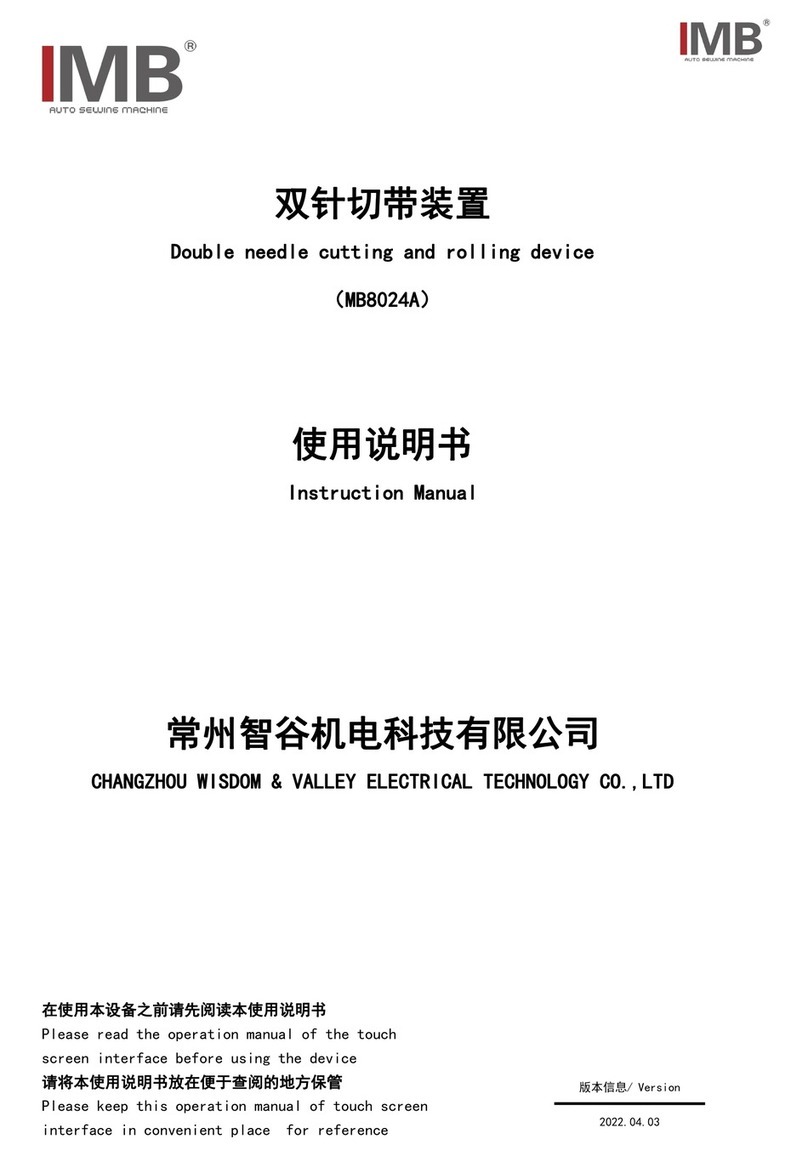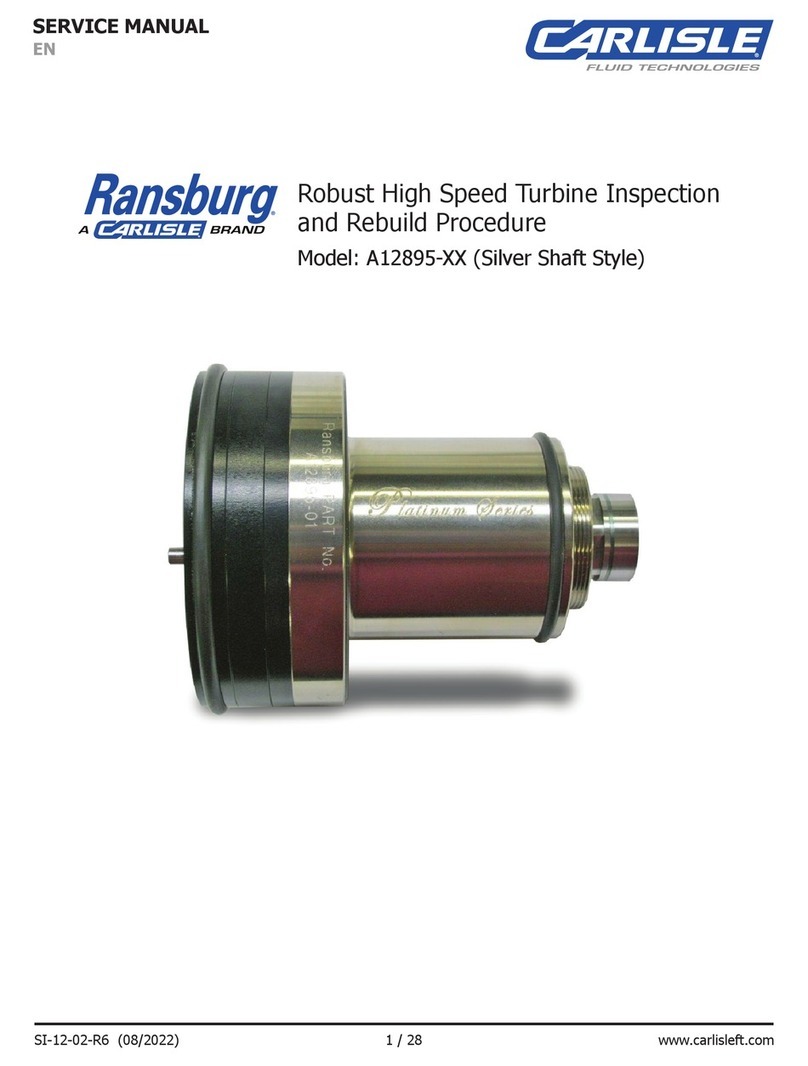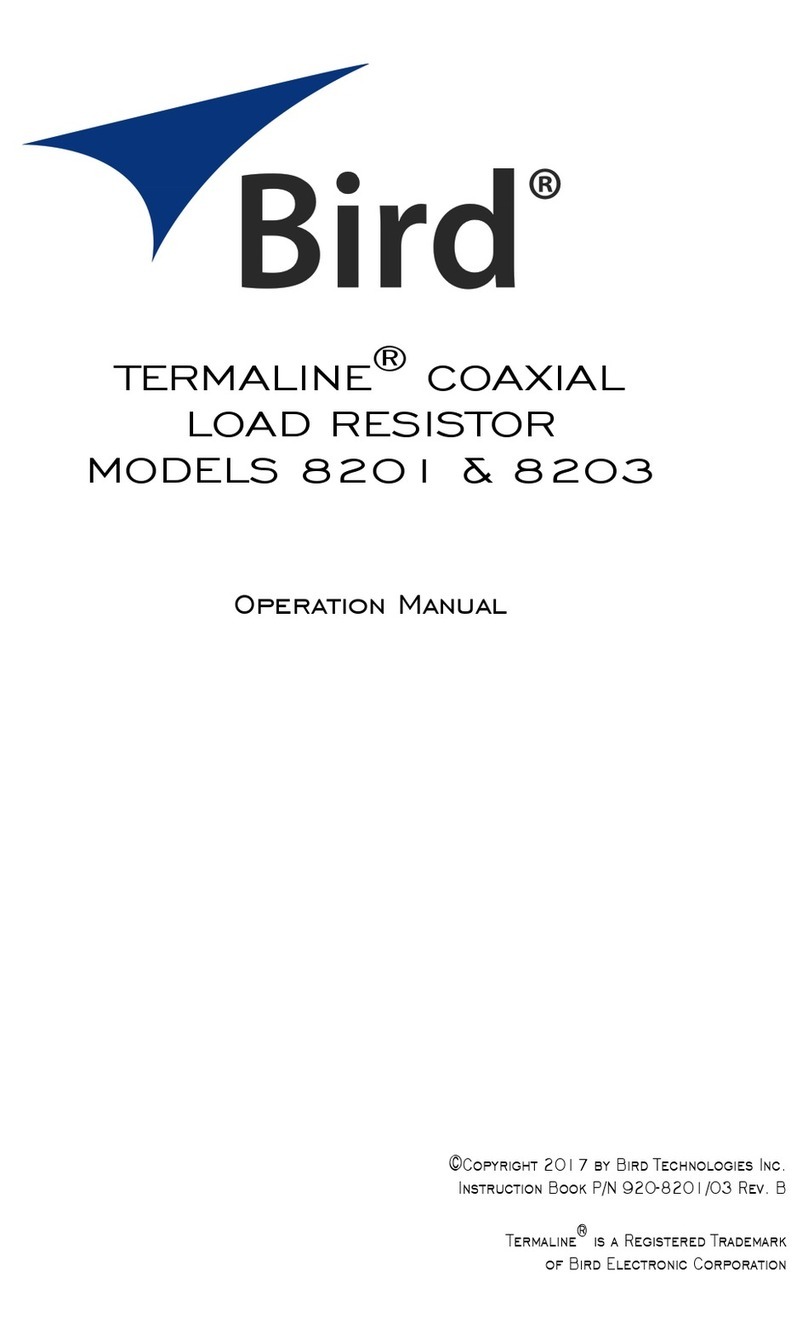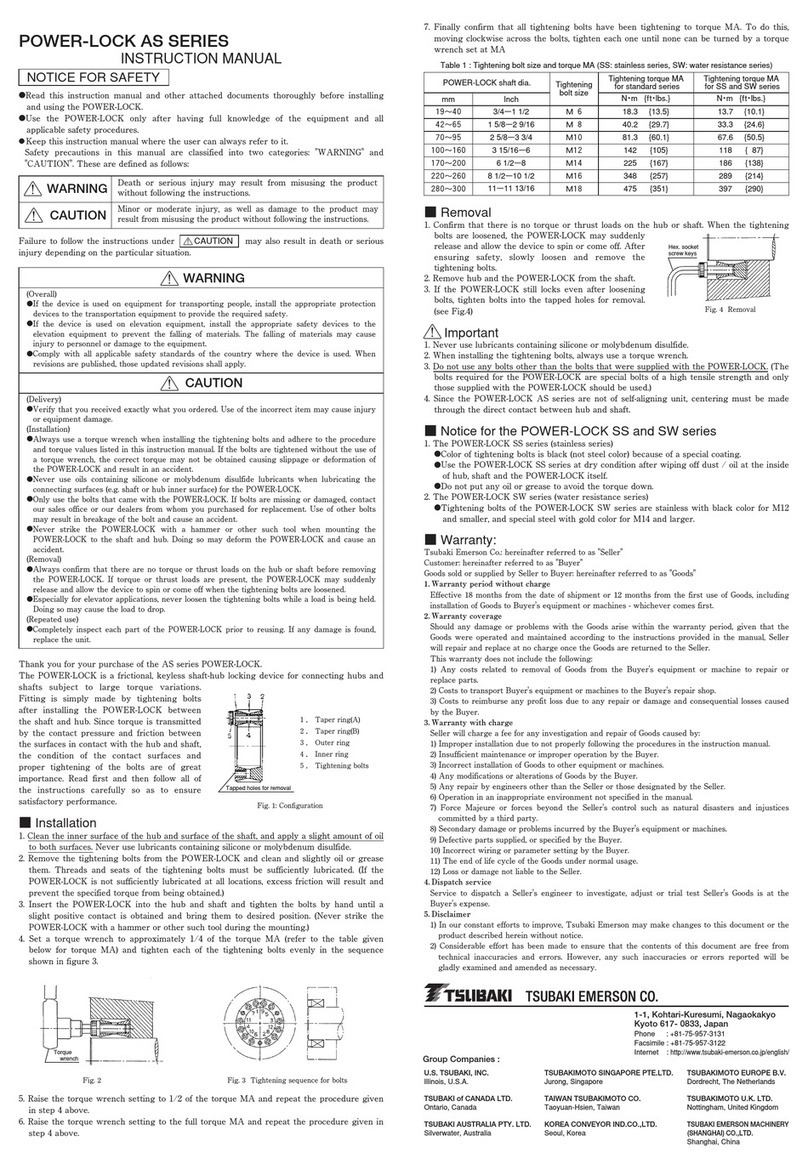Giebel Adsorber MA-R Quick guide

Assembly and maintenance
instructions
according to regulation DIN 82079
Version 06.20
Date: 21.10.2021
Name: Manual_MA-R_EN
GIEBEL FilTec GmbH | info@giebel-adsorber.de | Accessories & Spare parts: shop.giebel-adsorber.de 1/8
Adsorber MA-R
Section 1: Information on the manufacturer
Giebel FilTec GmbH
Carl-Zeiss-Str. 5
74626 Bretzfeld
Germany
Tel. +49 79 46 94 44 01 0
Fax +49 79 46 94 44 01 29
E-Mail info@giebel-adsorber.de
Section 2: Product overview
Sizes
Size 2
Size 3
Size 5
MA-R 2L
MA-R 3M / MA-R 3L
VV-R 5M
Materials used
Aluminium, acrylic glass, stainless steel, polyoxymethylene (POM), FKM, EPDM, silica gel orange,
activated carbon
REACH Note
No ingredients requiring disclosure under Regulation (EC) No 1907/2006.

Assembly and maintenance
instructions
according to regulation DIN 82079
Version 06.20
Date: 21.10.2021
Name: Manual_MA-R_EN
GIEBEL FilTec GmbH | info@giebel-adsorber.de | Accessories & Spare parts: shop.giebel-adsorber.de 2/8
Section 3: Construction and materials
Use
Reusable
Housing material
Aluminium
Adsorbents
Silica gel, activated carbon
Particulate filter
Filter element with 3 µm separation
efficiency
Seal material
FKM / EPDM
Operating
temperature
-40°C - +80°C
Connection
BSP / NPT / Metric / Slipfit
Section 4: Technical data
VV-R 2L
VV-R 3M
VV-R 3L
VV-R 5M
Total weight [kg]
1,7
2,3
3,3
4,6
Adsorbent [kg]
0,5
0,9
1,4
2,3
Max. Water absorption (ml)
200
360
560
920
Height [mm]
210
240
340
270
Housing diameter [mm]
90
110
110
150
Screw-in diameter [mm]
120
140
140
180
Connection
BSP, NPT, Metric,
Slipfit
BSP, NPT,
Metric, Slipfit
BSP, NPT, Metric,
Slipfit
BSP, NPT, Metric,
Slipfit
Valves [IN-OUT]
0 –0
0 –0
0 –0
0 –0

Assembly and maintenance
instructions
according to regulation DIN 82079
Version 06.20
Date: 21.10.2021
Name: Manual_MA-R_EN
GIEBEL FilTec GmbH | info@giebel-adsorber.de | Accessories & Spare parts: shop.giebel-adsorber.de 3/8
Section 5: Assembly and commissioning
1. Remove protective foil on the underside of the
adsorber.
2. Lightly oil the thread.
3. Screw the adsorber onto the system.
Section 6: Maintenance
Once the silica gel is completely saturated, a spare parts kit must be used.
0% →100%
If the colour of the silica gel has completely changed according to the colour indicator used, it must be
replaced.

Assembly and maintenance
instructions
according to regulation DIN 82079
Version 06.20
Date: 21.10.2021
Name: Manual_MA-R_EN
GIEBEL FilTec GmbH | info@giebel-adsorber.de | Accessories & Spare parts: shop.giebel-adsorber.de 4/8
1. Unscrew the adsorber from the system.
2. Open the lid using the clamps.
3. Remove the seal in the cover and replace it with the new one.
4. Remove the activated carbon disc and empty the desiccant.
5. Pull out the filter element.
6. Remove the lower foam disc as well.
7. Insert new foam disk.
8. Insert a new filter element and then fill in fresh desiccant When filling in the desiccant,
lightly tap the housing with a soft object (e.g. the ball of your hand) to compact the
bulk material.
9. Insert new activated carbon discs and then close the lid again using the clips
10. Screw the adsorber back onto the system.
Section 7: Spare parts and storage
Adsorber
Spare parts kit*
Desiccant
MA-R 1L
ET MA+ME-R 1
SOG 4 kg
MA-R 2L
ET MA-R 2
SOG 4 kg
MA-R 3M
MA-R 3L
ET MA-R 3
SOG 4 kg
MA-R 5M
ET MA-R 5
SOG 4 kg
Spare parts kit
- Silica gel
- Activated carbon
- Filter discs
- Filter element
- Seal kit
Desiccant
- Silica gel
Airtight packaging
Exemplary representation
of the spare parts set
*also as EPDM version

Assembly and maintenance
instructions
according to regulation DIN 82079
Version 06.20
Date: 21.10.2021
Name: Manual_MA-R_EN
GIEBEL FilTec GmbH | info@giebel-adsorber.de | Accessories & Spare parts: shop.giebel-adsorber.de 5/8
Order of spare parts
For a constant operational readiness of the adsorber and thus the plant, make sure that a spare parts kit
is always in stock.
The time until the complete colour change from and thus the service life of the adsorber depends on
various factors:
•Number and duration of flow and loading intervals.
•Air flow volume and flow velocity, relative humidity of ambient air.
•Temperature of the ambient air and the medium to be ventilated.
Storage of adsorbers
All articles filled with desiccant are packed airtight. To avoid damage to the desiccant, it must be stored
in dark and dry rooms at -10°C to +30°C.
Section 8: Disposal
Regeneration
In practice, the most common regeneration method used is the temperature increase. When desorbing
water vapour from silica gel, the temperature must be above 100°C. For silica gel with colour indicators a
regeneration temperature of 120°C should be maintained in order not to damage the colour indicator
applied.
It is nevertheless recommended to use fresh silica gel.
Disposal
At the end of its useful life, the device must be disposed of in accordance with the relevant legal
regulations. Metal and plastic parts should be separated and disposed of separately.
The loaded desiccant Silicagel Orange can be disposed of in household waste.
Silicagel Orange is not classified as a hazardous substance under European Union legislation
(Regulation EC No 1272/2008). It is not subject to compulsory labelling in accordance with EC Directive
(67/548/EEC or 1999/45/EC). Silicagel Orange is not considered to be a substance hazardous to health
or the environment.

Assembly and maintenance
instructions
according to regulation DIN 82079
Version 06.20
Date: 21.10.2021
Name: Manual_MA-R_EN
GIEBEL FilTec GmbH | info@giebel-adsorber.de | Accessories & Spare parts: shop.giebel-adsorber.de 6/8
Section 9: Risk and hazard analysis
1. Moist air flows into the system
Porous seals
Moist air can flow into the adsorber or into the plant at the porous points. This means that complete
drying is not possible and moist air enters the plant.
Saturated drying agent
When the desiccant is saturated, it can no longer absorb moisture. This allows moist air to enter the
system.
Air flow rate too high
If the air flow rate is too high, the contact time between moist air and desiccant is too short. This allows
moist air to flow into the system.
Oil on the drying agent
If too many oil particles enter the adsorber, the oil particles close the pores of the desiccant and thus
prevent adsorption.
Ambient temperature too high
If the ambient temperature exceeds 80°C, the binding forces in the desiccant decrease. This means that
the incoming ambient air is only dried to a limited extent.
2. Positive or negative pressure builds up in the system
Air flow rate too high
Too high an air flow rate can cause over- or underpressure in the system.
Contaminated filter element
The filter unit can be clogged by dirt particles and can therefore build up pressure in the system.
Oil on the drying agent
If oil particles get into the adsorber, the spaces in the fill can be filled with oil and the fill will stick
together. This can cause pressure to build up in the system.
3. Adsorber is damaged
Material resistance
When selecting the adsorber, the ambient and operating conditions should be considered. An aggressive
environment or liquid in the container can damage the adsorber.

Assembly and maintenance
instructions
according to regulation DIN 82079
Version 06.20
Date: 21.10.2021
Name: Manual_MA-R_EN
GIEBEL FilTec GmbH | info@giebel-adsorber.de | Accessories & Spare parts: shop.giebel-adsorber.de 7/8
Temperature range
The ambient and operating temperatures should not exceed or fall below the specified range, otherwise
the adsorber may be damaged.
Improper handling
Incorrect or improper handling can damage the adsorber. The recommended installation must be
observed.
Strong vibrations
Strong vibrations of the plant can damage the adsorber.
Pressure range of the system
The adsorber should not be exposed to over- or underpressure above 0.5 bar, otherwise the housing
may be damaged.
Thread of the adsorber and accessories is damaged
When mounting the adsorber on the system, the threads must be
slightly moistened with oil. Failure to lubricate the threads can
lead to the thread rubbing and is not a reason for complaint.
Section 10: Maintenance plan
1. Check seals for wear
Check The O-rings installed in the adsorber and the flat gasket must be checked for perfect
condition. For this purpose the seals in the lid, on the filter and on the connection should
be checked and examined for brittleness.
Cycle Half-yearly
Measures In case of existing damage, a new spare parts kit or a new adsorber should be used.

Assembly and maintenance
instructions
according to regulation DIN 82079
Version 06.20
Date: 21.10.2021
Name: Manual_MA-R_EN
GIEBEL FilTec GmbH | info@giebel-adsorber.de | Accessories & Spare parts: shop.giebel-adsorber.de 8/8
2. Visual inspection of the silica gel
Check The loading condition of the silica gel must be determined by visual inspection of the
adsorber. The colour orange indicates that the silica gel can still adsorb water and air is
dehumidified. When the silica gel is completely saturated, the colour changes to green or
colourless.
If there are oil particles on the silica gel, these close the pores and the adsorption capacity
is reduced. This causes the silica gel to discolour more slowly and unevenly.
Cycle Half-yearly
Measures If the silica gel is loaded or damaged by oil, a new spare parts kit or a new adsorber with
fresh silica gel should be used.
3. Check filter unit for impurities
Check Take off the lid and remove the activated carbon disc. Then empty the desiccant. The filter
unit can then be removed. This should be checked for contamination and should be free of
dirt for smooth operation.
Cycle Half-yearly
Measures The filter element is part of the spare parts kit and should be replaced if it is contaminated.
4. Visual inspection of the adsorber
Check The adsorber must be checked visually for damage. Damage can occur due to various
environmental or operating conditions.
Zyklus Yearly
Measures If the adsorber is damaged, it must be completely replaced to ensure full functionality.
5. Replacing the wearing parts
Check The wearing parts, in particular the seals, the silica gel as well as the adsorber housing,
must be checked with regard to their condition.
Cycle Every two years
Measures Regardless of the result of the test, it is recommended to replace the wearing parts by
using a spare parts kit or a new adsorber to ensure smooth operation.
Table of contents
Other Giebel Industrial Equipment manuals
Popular Industrial Equipment manuals by other brands

Lissmac
Lissmac SBM-XL 1000 S2B2 operating manual
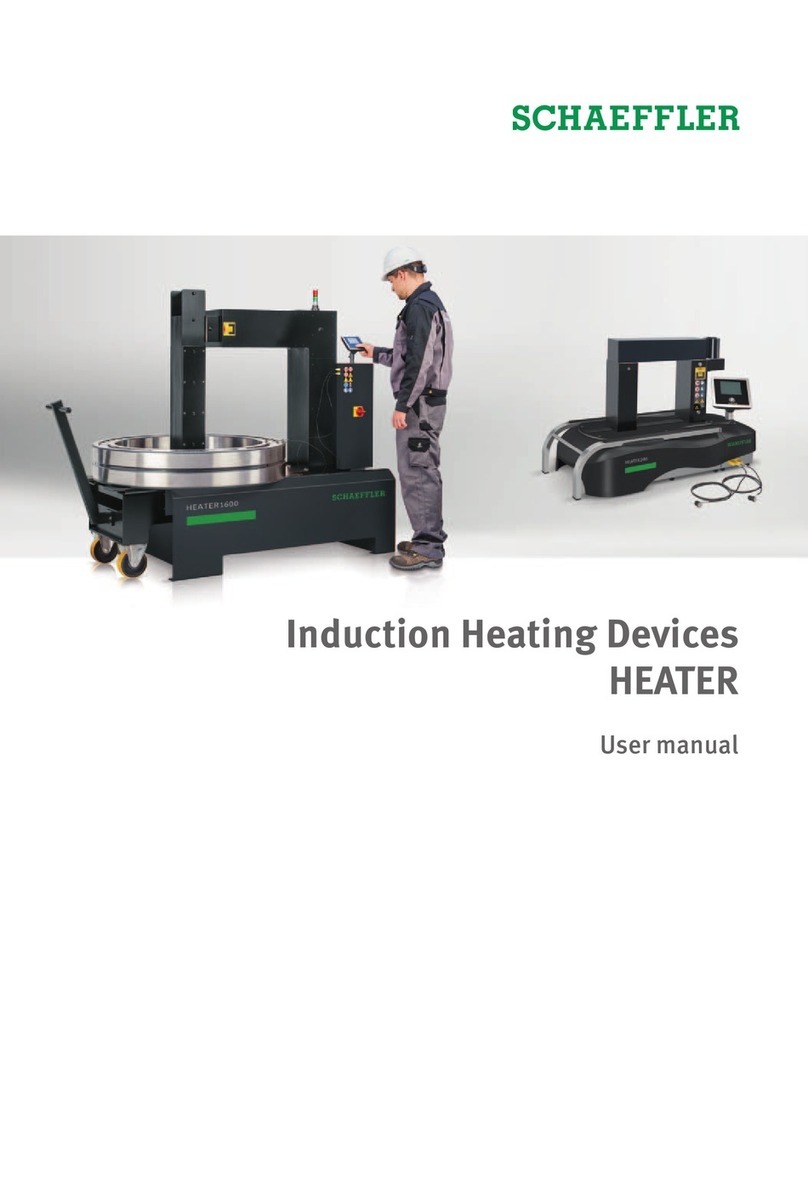
Schaeffler
Schaeffler HEATER Series user manual

Baileigh Industrial
Baileigh Industrial BR-16E-36LT Operator's manual
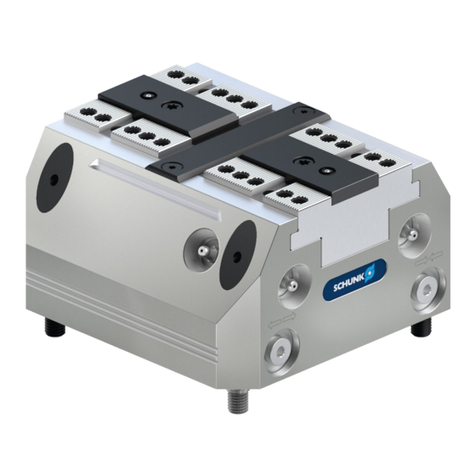
SCHUNK
SCHUNK TANDEM KSH3 Assembly and operating manual
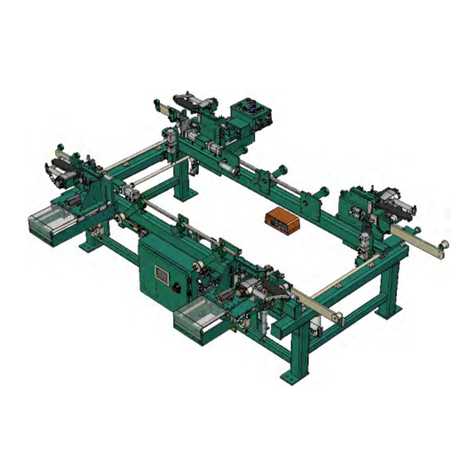
Kval
Kval 700-C System reference
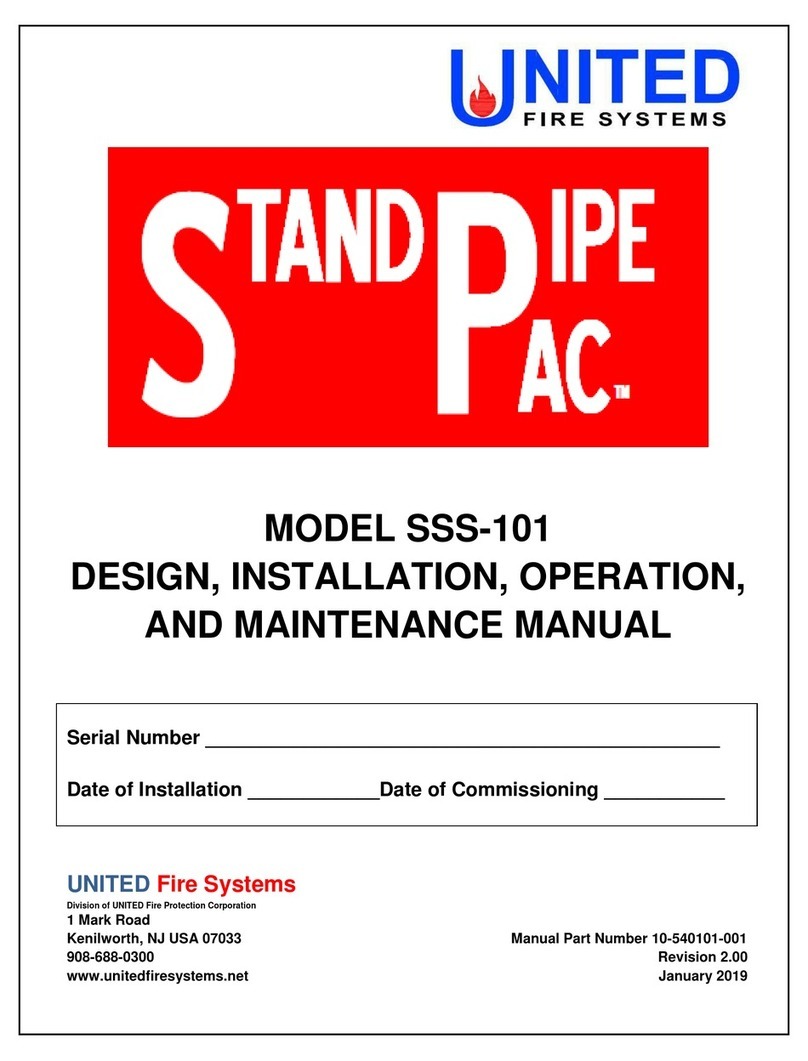
UNITED Fire Systems
UNITED Fire Systems STANDPIPE-PAC SSS-101 Design, Installation, Operation, and Maintenance Manual
